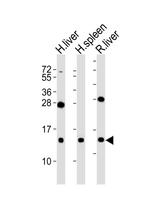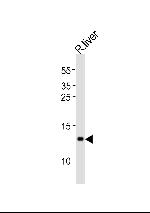Search Thermo Fisher Scientific
FIGURE: 1 / 2
CXCL11 Antibody (PA5-116353) in WB


Product Details
PA5-116353
Species Reactivity
Host/Isotype
Class
Type
Immunogen
Conjugate
Form
Concentration
Purification
Storage buffer
Contains
Storage conditions
Shipping conditions
RRID
Target Information
Interferon-inducible T-cell alpha chemoattractant ( I-TAC), belonging to the CXC chemokine family, is expressed in peripheral blood leukocytes, pancreas and liver, thymus, spleen, lung, small intestine, placenta and prostate. Its molecular weight is 8-11 kD. I-TAC is also known as CXCL-11 and IP-9. The cytokine is involved in regulating calcium release and inducing a chemotactic response in activated T-cells and is the dominant ligand for CXC receptor-3. The gene encoding this protein contains 4 exons and at least three polyadenylation signals which might reflect cell-specific regulation of expression. IFN-gamma is a potent inducer of transcription of this gene. It is upregulated in patients with AIDS, dementia and in patients with multiple sclerosis.
For Research Use Only. Not for use in diagnostic procedures. Not for resale without express authorization.
References (0)
Bioinformatics
Protein Aliases: Beta-R1; C Cmotif chemokine; C X C motif chemokine; C-X-C motif chemokine 11; CC motif chemokine; CCmotif chemokine; chemokine (C-X-C motif) ligand 11; CXC; CXC motif chemokine; CXCL; H174; I-TAC; Interferon gamma-inducible protein 9; Interferon-inducible T-cell alpha chemoattractant; IP-9; MGC102770; small inducible cytokine B11; small inducible cytokine subfamily B (Cys-X-Cys), member 11; small inducible cytokine subfamily B (Cys-X-Cys), member 9B; Small-inducible cytokine B11
Gene Aliases: b-R1; CXCL11; H174; I-TAC; IP-9; IP9; ITAC; SCYB11; SCYB9B
UniProt ID: (Human) O14625
Entrez Gene ID: (Human) 6373, (Rat) 305236

Performance Guarantee
If an Invitrogen™ antibody doesn't perform as described on our website or datasheet,we'll replace the product at no cost to you, or provide you with a credit for a future purchase.*
Learn more
We're here to help
Get expert recommendations for common problems or connect directly with an on staff expert for technical assistance related to applications, equipment and general product use.
Contact tech support
